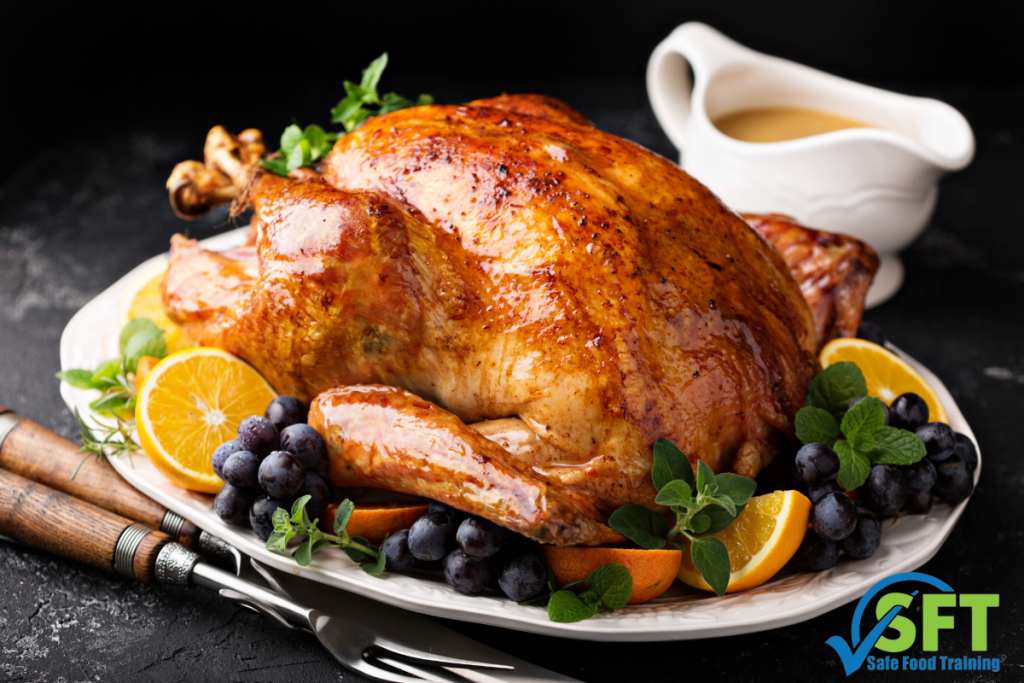
With Thanksgiving just two weeks away, kitchens across Minnesota are gearing up for the busiest day of food service of the year. For a certified food protection manager, the holiday rush presents the single greatest challenge to maintaining food safety standards. The combination of complex menus, high-volume orders, temporary staff, and the sheer chaos of the day creates a perfect storm for critical errors.
According to the CDC, about 48 million Americans get sick from foodborne illnesses each year. The Thanksgiving holiday, centered on a high-risk food like turkey, is a notorious contributor to these statistics.
As food professionals, it’s our job to protect public health. Let’s review the three most common—and most dangerous—food safety blunders that happen during the holiday rush.
Blunder #1: The Great Turkey Thaw Catastrophe
This is a very frequent mistake, and it starts days before the holiday. A frozen turkey is essentially a block of ice, and thawing it improperly is a direct invitation for bacterial growth.
The primary culprit is thawing the bird on the kitchen counter. While convenient, this method is incredibly dangerous. As the turkey’s outer layers thaw, they quickly enter the temperature danger zone (41°F to 135°F). Meanwhile, the center remains frozen solid. In this danger zone, bacteria like Salmonella can double in as little as 20 minutes. The USDA is unequivocal: never thaw a turkey at room temperature.
Here are the only safe methods your team should use:
- Refrigerator Thawing (Recommended): This is the safest, most controlled method. Place the turkey in a pan or on a tray (to catch drips) on the bottom shelf of the refrigerator. You must budget adequate time: allow one full day (24 hours) for every 4-5 pounds of turkey. A 20-pound bird will take 4 to 5 days to thaw completely.
- Cold Water Thawing (Active): This method is faster but requires constant attention. Submerge the leak-proof packaged turkey in cold tap water. You must change the water every 30 minutes to ensure it stays cold. This method takes approximately 30 minutes per pound. This process requires your active participation.
Blunder #2: A Certified Food Protection Manager’s Blind Spot—Cross-Contamination
When the kitchen is in overdrive, basic protocols are the first to fall by the wayside. Cross-contamination from raw poultry is a massive risk that managers must expect. Raw turkey juice contains pathogens, and even a tiny amount can contaminate ready-to-eat (RTE) foods like salads or desserts.
This goes far beyond just cutting boards. Holiday prep involves dozens of high-touch surfaces and multitasking staff.
- Improper Handwashing: This is the #1 vector. A cook handles the raw turkey, rinses their hands quickly (or just wipes them on an apron), and then grabs a refrigerator handle, a spice container, or a spatula. That surface is now contaminated. Solution: Emphasize thorough 20-second handwashing after touching raw poultry and schedule frequent sanitizing of all high-touch surfaces.
- Cutting Board Control: Staff must use separate, color-coded cutting boards for raw poultry and RTE foods (such as vegetables for a relish tray). If you see a cook slice raw turkey and then just “wipe” the board before chopping celery, that is a critical violation.
- Storage and Prep: In packed walk-in coolers, it’s tempting to shuffle things around. Always store raw turkey on the bottom shelf, below all other foods, especially RTE items. This prevents any potential drips from contaminating food below.
Blunder #3: Failing the Holding and Reheating Test
Getting the food cooked is only half the battle. Thanksgiving meals are often buffet-style or served for extended periods. This final stage is where many operations fail.
- Improper Hot-Holding: Food on a buffet line or steam table must be held at 135°F or higher. As a manager, you must ensure staff check temperatures with a calibrated thermometer at least every 2 hours (or more frequently, depending on your HACCP plan). Discard any food that falls into the temperature danger zone.
- The Cooling Catastrophe: You can’t just put a 5-gallon pot of hot gravy or a deep pan of stuffing directly into the walk-in cooler. This raises the ambient temperature of the cooler, putting other foods at risk, and the food itself will not cool fast enough. Solution: Use the two-stage cooling method (135°F to 70°F within 2 hours, then 70°F to 41°F within the next 4 hours). This requires active cooling with ice paddles or ice baths, or by dividing food into shallow pans.
- Reheating Right: You must reheat leftovers correctly. You cannot simply “warm up” gravy on a steam table. You must rapidly reheat all leftovers to 165°F for 15 seconds before serving or placing them in hot-holding equipment.
The Thanksgiving rush is the ultimate test of your systems and your team’s training. As a Certified Food Protection Manager, your leadership in these critical moments protects your customers and your business’s reputation.
Stay Compliant and Confident This Holiday Season



Don’t let the holiday rush expose a gap in your team’s knowledge. Whether you need your initial certification or it’s time for your three-year renewal, Safe Food Training is here to help.
Jeff Webster provides personalized, expert-led training designed specifically for Minnesota food professionals. We offer our comprehensive 8-hour Certified Food Protection Manager course and dedicated continuing education sessions.
Visit our website to register yourself or your team for an upcoming course today.


